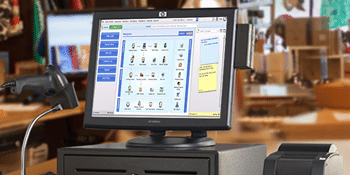The Advantages of QuickBooks Point of Sale Merchant Services

Pete Real
Intuit, the company behind the QuickBooks family, is well-known for its accounting software. The company has also branched out into additional complementary product offerings such as payroll and point-of-sale (POS) software packages. Because it is so heavily used by small businesses, QuickBooks features the ability to integrate its merchant processing services with QuickBooks Point of Sale software.
Comparison of QuickBooks Versions
QuickBooks Point of Sale comes in Basic and Pro versions. You can evaluate the functionality built into each to determine which will best accommodate the needs of your business, though in general Pro offers more customization of the system’s features. For example, its Document Designer can create custom receipts, price tags, work orders, and the like. If you have a multi-store operation, you will definitely need Pro, as Basic does not support more than one location.
If you accept credit and debit cards—and these days doing so isn’t really optional for most businesses—you’ll find it much more efficient to integrate your credit card processing with your POS system. QuickBooks Point of Sale can be paired with Intuit’s merchant service for seamless integration. While it’s certainly possible to take cards through other systems (like a traditional standalone terminal) and enter those transactions in the POS software, doing so is more time-consuming than necessary.
Do You Really Need a Physical Terminal?
There is no need for the cost of a completely separate piece of hardware, which is also one more thing to potentially break. Having a separate terminal adds to the time needed to process a sale, something you’ve probably encountered yourself in a variety of retail settings. The sale is processed through the POS system, you offer a card to pay, and then the transaction has to be entered in the terminal, processed, and the payment tender entered in the POS system. Aside from taking longer, this creates more opportunity for errors to creep in, such as an incorrect sale amount entered on the terminal. It also unnecessarily complicates split payment methods, when a customer pays part of the ticket with cash (or some other tender like a gift card) and part with a credit or debit card.
Use Your Computer as Your POS
On the subject of hardware, QuickBooks Point of Sale runs on a computer, meaning there’s no need for a full cash register and other POS equipment. Intuit offers cash drawers, barcode scanners, displays, PIN pads, and all the other pieces needed to make up a POS system. That means upgrading requires just a few hundred dollars for a new computer, not a few thousand for a whole new POS system.
The nice thing is that at the end of each business day, reconciling your card transactions with your POS system is a breeze. The integration between QuickBooks Point of Sale and the merchant service means most of the work is already done for you. In comparison, batching out a standalone terminal and then reconciling the batch transactions with your sales records can quickly turn into a headache if there is a discrepancy (such as one caused by the kind of data entry error mentioned above).
Seamless Financial Tracking through QuickBooks
Finally, all the data captured in QuickBooks Point of Sale (including credit card transactions) will flow seamlessly into your QuickBooks accounting software. Again, what can be a tedious and time-consuming manual process is extensively automated by the integration between these systems. In addition, back-end services like ordering merchandise or raw materials from your suppliers are also integrated. Your Point of Sale software tracks inventory levels and tells you when to reorder, your purchase orders are created in QuickBooks, and inventory received is tracked in both places as it arrives.
The accounting for even a small retail business can very quickly become a full-time job. The more automation you can introduce, the more you will be able to focus your labor dollars—and your own time—on servicing customers and doing things that drive sales instead.
















